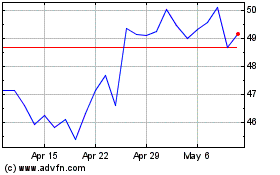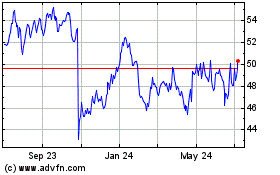Drug Pricing Report Shows Limits of Transparency Push
December 31 2016 - 9:30AM
Dow Jones News
By Peter Loftus
A new Vermont law -- the first of its kind in the U.S. -- aims
to shine a light on the murky world of prescription-drug pricing by
requiring manufacturers to justify big increases.
But the transparency push has its limits, as seen in the first
report that Vermont officials prepared based on the drugmakers'
explanations.
The Vermont law, enacted in June, instructed state officials to
identify up to 15 drugs annually with price increases of at least
15% in the prior year, or 50% over the prior five years, and on
which the state spends significant money through programs such as
Medicaid.
The law requires the Vermont attorney general's office to seek
explanations from the companies and issue an annual report based on
the responses.
The first report, issued this month, identified 10 drugs. They
included Mylan NV's EpiPen allergy treatment, whose price rose
about 205% over five years; Sanofi SA's Lantus insulin, up 90%; and
AbbVie Inc.'s rheumatoid-arthritis treatment Humira, up 114%.
Manufacturers were asked to submit all factors that contributed
to price increases, and percentages attributable to each factor.
But none of their answers are in the report. The 11-page document
merely summarizes some of the reasons given, such as the industry's
need to invest in research and manufacturing.
That is because the law has a confidentiality provision, so none
of the companies' written responses are publicly available.
Jill Abrams, a Vermont assistant attorney general, said she
couldn't discuss details from the companies' responses.
"Some of the information is probably more synthesized and
summarized than what we might have envisioned, and in that sense is
perhaps a little less helpful than we might have hoped," said state
Rep. Anne Donahue, who voted for the drug-price transparency
bill.
The law also doesn't give the state the power to cap or roll
back prices that it deems excessive. The state can only levy a
$10,000 fine to companies that don't provide information about
their price increases.
The Vermont law is part of a broader movement to increase
drug-price transparency, which supporters say could pressure
companies to rein in costs. Other states including California are
considering laws similar to Vermont's, and in September U.S. Sens.
John McCain and Tammy Baldwin proposed legislation to require
drugmakers to justify to the federal government any drug-price
increases of more than 10%.
The industry has lobbied against state pricing proposals. The
Pharmaceutical Research and Manufacturers of America said in a
statement the Vermont law ignores cost savings that medicines can
provide to the health system, and focuses too much on list
prices.
Vermont lawmakers included the confidentiality provision out of
concern that the industry wouldn't comply, or would challenge the
law in court, said Ms. Donahue, a Republican. It states that
officials can't release the company information "in a manner that
allows for the identification of an individual drug or manufacturer
or that is likely to compromise the financial, competitive, or
proprietary nature of the information."
Vermont State Rep. Christopher Pearson, a lead supporter of the
law, said the drug-transparency report has "limited information."
But he added that "we're starting to peel back some of the layers
of the onion here." Mr. Pearson, a Progressive, said the law's
intent was to identify trends that could help explain why
prescription costs are escalating, which he said could guide
legislative action. Vermont lawmakers may hold hearings and discuss
further action on the report, he said.
Eight of the drugmakers listed in the report declined to share
with The Wall Street Journal the written responses they provided to
the Vermont attorney general's office, citing the law's
confidentiality provision. Another company didn't respond to
requests for comment. A 10th company, Mutual Pharmaceutical,
couldn't be reached for comment. The price of Mutual's generic
antibiotic doxycycline soared more than 4,700% in the past five
years, the report said.
Amgen Inc. said in a recent regulatory filing the Vermont law
was an example of state government actions that "create additional
pressure on how our products are priced." Amgen's Enbrel
anti-inflammatory treatment was among the drugs listed in the
Vermont report; its price rose 93% over five years.
Several of the companies said in comments to the Journal they
priced their drugs based on the economic value to patients and
insurers.
The state's report indicated that manufacturers said they offer
rebates and discounts that reduce the costs of many drugs, though
it didn't quantify the price concessions.
Write to Peter Loftus at peter.loftus@wsj.com
(END) Dow Jones Newswires
December 31, 2016 09:15 ET (14:15 GMT)
Copyright (c) 2016 Dow Jones & Company, Inc.
Sanofi (NASDAQ:SNY)
Historical Stock Chart
From Aug 2024 to Sep 2024

Sanofi (NASDAQ:SNY)
Historical Stock Chart
From Sep 2023 to Sep 2024
